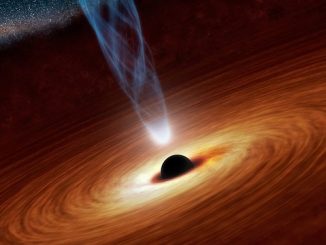
In 1915, Albert Einstein put forth the Theory of General Relativity. In the subject of gravity, Einstein’s theory is arguably the most complete and refined theory of all time. It has never failed to explain almost everything from the simplest things up to things that span our universe, right down to the smallest detail.
Einstein’s Theory of General Relativity challenged Newton’s gravitation back then. In fact, Einstein’s theory has since been proven to be more accurate, explaining situations where Newton’s gravitation will fail. It goes without saying that the theory of relativity has broadened our knowledge on some important principles. That said however, right now, we are on the cusp of replicating what Einstein’s theory did to Newton’s gravitation and the challenge came from a system composed of three dead stars.
The PSR J0337+1715 is a millisecond pulsar that was announced back in 2014. As stated earlier, it is composed of three dead stars located 4200 light years away in the constellation Taurus. These stars are interacting with each other in a way that could either confirm the Theory of General Relativity or topple it down.
Let’s paint a better picture of the PSR J0337+1715. This is a cold white dwarf, what was once a star that resembled the sun, at approximately the same distance from the center of this system as Earth orbits the sun. When you move further in, you’ll encounter a hotter white dwarf. Every 1.6 days, the inner white dwarf moves around another, one that’s invisible to the naked eye.
This companion can be seen through x-ray and gamma-ray vision, and it makes the two white dwarfs look small. It’s a spherical object that’s 24 km wide and almost 1.5 times the mass of the sun. This object is a pulsar, what remains of a larger star. It whirls at an amazing frequency of once in every 2.73 milliseconds.
Each whirl sends a tick mark here on Earth ; the interesting thing is that this has been going on for years. It is exactly this accurate tick mark that serves as a clock as well as the system’s tangled gravitational fields that makes this a perfect opportunity to test Einstein’s theory. In fact, the discoverers are doing just that by taking note of one principle in particular – the equivalence principle.
According to Theory of General Relativity’s equivalence principle, “gravity accelerates all objects equally regardless of their masses or the materials from which they are made”. It is much like free fall, the mass will not have any effect in the way gravity pushes it down. Now, for the equivalence principle to hold true, the outer white dwarf should have the same effect on both the pulsar and the inner white dwarf.
If it does not, then we can expect that the inner pair will be more elliptical than expected. That will then violate the equivalence principle and, in turn, disprove Einstein’s Theory of General Relativity. Of course, this will be quite a shock, but not entirely unexpected since General Relativity is the only gravitational theory that does not predict the failure of equivalence theory at some point or another.
The PSR J0337+1715 could be a great way to either prove or disprove Einstein’s Theory of General Relativity. After all, in this case, we will not have to rely on a simulation and we will not be confined by our imagination. This system of three dead stars is the perfect way to present physical and tangible evidence. Unfortunately, all we can do right now is wait and see.
Reference: New Scientist




You don’t need to use its conclusion to disprove Einstein’s relativity because relativity has got its logical error in its very spacetime model. Unlike using data to indirectly confirm or disprove relativity such as the case in this article which can never be decisive, the logical disproving of relativity is conclusive without any ambiguity. The logical error of relativity is that Einstein has redefined space and time through Lorentz Transformation and the newly defined time (relativistic time) is no longer the same physical time we measure with physical clocks (see “Challenge to the special theory of relativity” Physics Essays Volume 29: Pages 142-148, 2016) because the clock time is always absolute and universal no matter whether in special relativity or in Galilean relativity.
First, let’s have a look at the thought experiment of candle clocks. There are a series of vertically standing candles with the same burning rate and moving at different constant horizontal velocities in the inertial reference frame of (x, y, z, t). At any moment t, all candles have the same height H in the frame of (x, y, z, t). Therefore, we have the events of the observation: (Candle1, x1, y1, H, t), (candle2, x2, y2, H, t), …, (CandleN, xN, yN, H, t) in the frame of (x, y, z, t). When these events are observed on anther horizontally moving inertial reference frame (x’, y’, z’, t’), according to special relativity, these events can be transformed to the frame of (x’, y’, z’, t’) through Lorentz Transformation: (Candle1, x1′, y1′, H, t1′), (Candle2, x2′, y2′, H, t2′), … , (CandleN, xN’, yN’, H, tN’) where t1′, t2′, …, and tN’ are relativistic times of the events in the frame of (x’, y’, z’, t’). It is seen that these events have different relativistic times after Lorentz Transformation in the frame of (x’, y’, z’, t’), i.e., they are no longer simultaneous measured with relativistic time in the frame of (x’, y’, z’, t’), but the heights of the candles remain the same because the vertical heights here do not experience any Lorentz contraction. Since the heights of the candles are the measures of the physical time, we can see these events still have the same physical time, i.e., they are still simultaneous measured with the physical time. Therefore, the physical time is invariant of inertial reference frames, which is different from relativistic time. As relativistic time is no longer the physical time we measure with physical devces, the description of special relativity is irrelevant to the physical world.
Now let’s have a look at the symmetric twin paradox. Two twins made separate space travels in the same velocity and acceleration relative to the earth all the time during their entire trips but in opposite directions. According to special relativity, each twin should find the other twin’s clock ticking more slowly than his own clock during the entire trip because of the relative velocity between them because acceleration did not have any effect on kinematic time dilation in special relativity. But when they came back to the earth, they found their clocks had exact the same time because of symmetry. Thus, there is a contradiction which has disproved special relativity. This thought experiment demonstrates that relativistic time is not our physical time and can never be materialized on physical clocks.
Now let’s look at clocks on the GPS satellites which is thought as one of the evidences of Einstein’s relativity.
Many physicists claim that clocks on the GPS satellites are corrected according to both special relativity and general relativity. This is not true. The corrections of the atomic clocks on the GPS satellites are absolute changes of the clocks, none of which is relative as claimed by special relativity. After all corrections, the clocks are synchronized not only relative to the ground clocks but also relative to each other, i.e., time is absolute and special relativity is wrong.
This is a fact as shown on Wikipedia. But some people argue that the clocks on the GPS satellites are only synchronized in the earth centered inertial reference frame, and are not synchronized in the reference frames of the GPS satellites. If it were true, then the time difference between a clock on a GPS satellite and a clock on the ground observed in the satellite reference frame would monotonically grow because of their relative velocity while the same clocks observed on the earth centered reference frame were still synchronized. If you corrected the clock on the satellite when the difference became significant, the correction would break the synchronization of the clocks observed in the earth centered frame. That is, there is no way to make a correction without breaking the synchronization of the clocks observed in the earth centered frame. Therefore, it is wrong to think that the clocks are not synchronized in the satellite frame.
Hefele-Keating experiment is also considered as another evidence of relativistic effects. It is clear that all the differences of the clocks after flights in Hefele-Keating experiment were absolute (i.e., they were the same no matter whether you observe them on the earth, on the moon or on the space station). But according to relativity, if the clocks were observed on the earth, the two clocks after flights had experienced the equivalent paths of same velocity and same distance in same elevation, and thus should generate the same kinematic time dilation and the same gravitational time dilation, directly contradicting the experimental result. Therefore, the differences of the clocks were nothing to do with the velocities relative to each other or relative to the earth as claimed by special relativity, but were the result of the velocities relative to one medium which seems fully dragged by the earth on its surface but partially dragged on the altitude of the airplanes. It is wrong to interpret the differences of the displayed times of the clocks as the results of relativistic effects.
All so-called relativity proofs are just misinterpretations of experiments and observations without exception, and all what relativity describes is irrelevant to physical phenomena, including the speed of light which in special relativity is constant in all inertial reference frames, but which in real physical world still follows Newton’s velocity addition formula (see the paper).